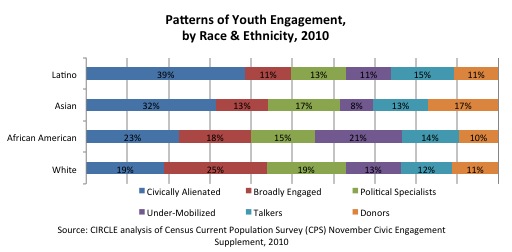Latino Youth: Political Engagement Trends
Latino youth saw an increase of 46.6% to 48.9% in their voter registration rates between 2008 and 2012, even as youth of other racial and ethnic backgrounds all experienced declines, but the voting rates of young Hispanics (ages 18-29) still lag behind those of their peers and they remain the most “civically alienated” group.
Those and other findings are described in our recent fact sheet about the patterns in electoral engagement of young Latinos, one of three fact sheets about political participation trends by youth of different racial and ethnic groups.
Young Latinos’ support of President Obama accompanied an increase in voter turnout from 2004 to the last two presidential contests. However, Hispanic youth turnout in 2012 (36.9%) decreased from 2008, and was significantly lower than that of their White (46.1%) and African American (53.7%) peers. In the 2010 midterm elections, young Latinos’ turnout rate of 17.6% equaled that of young Asian Americans as the lowest among all racial and ethnic groups.
When we analyze the patterns of engagement by young people of different backgrounds, Latino youth also rank as the least likely to be “broadly engaged” and most likely to be civically alienated. However, young Hispanics are slightly more likely than other groups to be “talkers”, a pattern of engagement that involves frequent discussion of political issues. Additionally, young Latinos donate to charitable causes at about the same rate as their White and African American peers.

Additional findings and recommendations include:
- Young Latinos were more likely to identify as Liberal Democrats (32%) than their White (19%) and African American counterparts (28%).
- Gender matters: 82% of young Latinas voted for Barack Obama in 2012, while only 66% of young Hispanic
men did. - Efforts to reach young Latinos should leverage their interest in having conversations about important public issues and use it as an entry point to broader engagement.
- Unlike other youth, Latino youth do not consider lack of information about the issues or process their primary barrier to participation. Instead, they feel disempowered, with many saying that their vote would not make a difference. Engagement efforts must understand and work to counter
this understandable cynicism and apathy.





